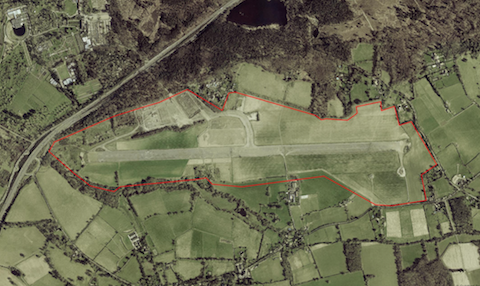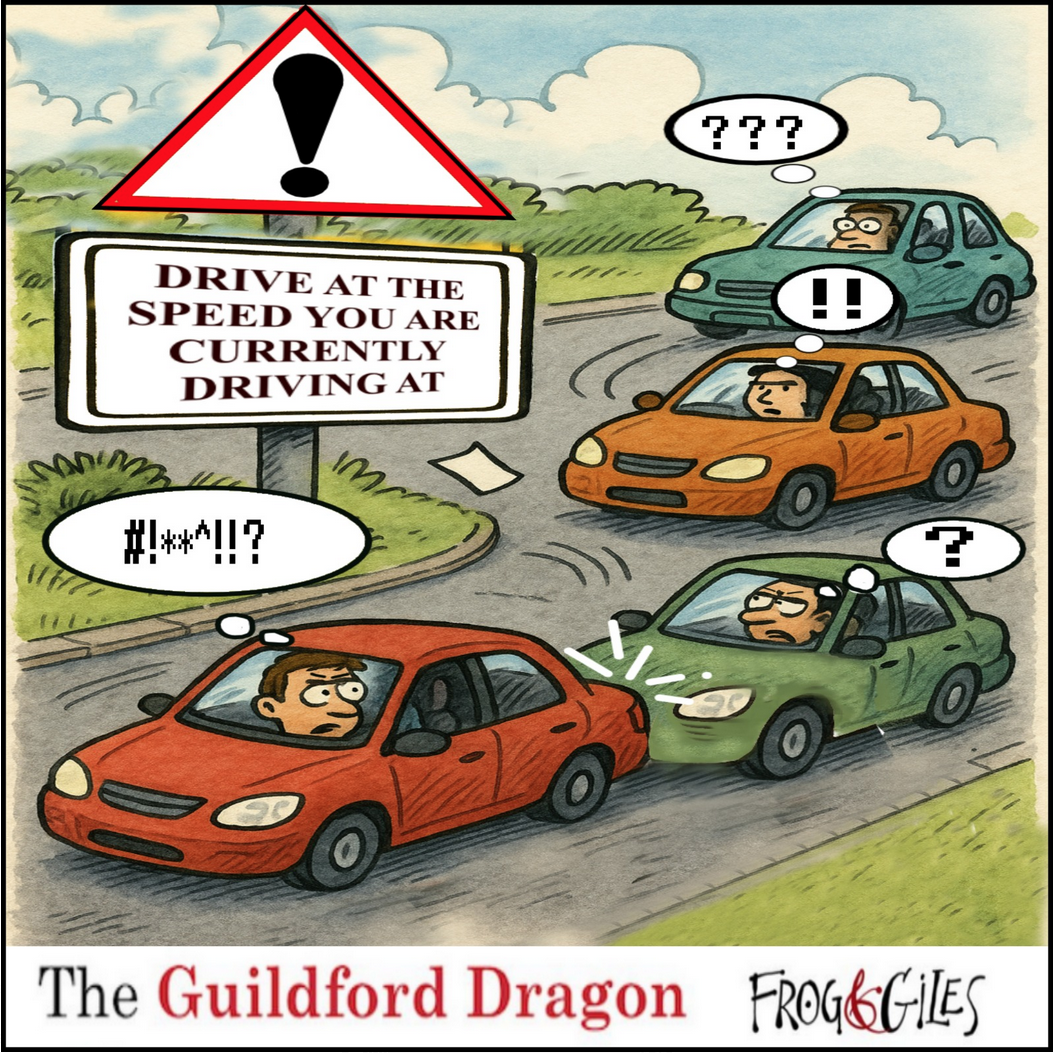 Abraham Lincoln
If given the truth, the people can be depended upon to meet any national crisis...
Abraham Lincoln
If given the truth, the people can be depended upon to meet any national crisis...
 Guildford news...
for Guildford people, brought to you by Guildford reporters - Guildford's own news service
Guildford news...
for Guildford people, brought to you by Guildford reporters - Guildford's own news service
Council Rejects Wisley Airfield Housing Development Proposal
Published on: 6 Apr, 2016
Updated on: 10 Apr, 2016

Aerial photograph of the site marked in red of the proposed development. From Guildford Borough Council’s planning officers’ report.
Guildford Borough Council (GBC) has this evening (April 6) voted unanimously to reject a planning proposal for 2,000 houses on a site at Three Farm Meadows, by the former Wisley airfield and Ockham village.
Council planning officers had earlier recommended refusal but the site remains listed as a potential strategic housing development site in the revised Local Plan issued by GBC yesterday.
Tony Edwards, a spokesman for the Wisley Action Group (WAG) which has been campaigning against the proposal, said: “The council’s 14 reasons for recommending rejection are just the tip of a much bigger iceberg of woolly proposals, flimsy evidence and misleading statements which have characterised the application.
“It was, and remains quite simply, the wrong project in the wrong place.”
The Surrey Branch of the Campaign to Protect Rural England (CPRE) also welcomed the decision.
Branch Director Andy Smith said: “CPRE has consistently opposed building on this green belt site. We were pleased last month when Guildford planning officers recommended refusal of the latest application and even more delighted to hear tonight that councillors had agreed with their planning officers and had voted to reject the application.
“It will be interesting now to see whether the Wisley site will be removed completely from Guildford’s revised draft Local Plan, published yesterday, which envisaged a development of 2,500 homes at Wisley.
“Surely there is no justification now for leaving this shadow hanging over the site? In our view there is no compelling case for building thousands of homes on Three Farm Meadows.
“If any other such development schemes are proposed for green belt countryside around Guildford, we will fight those too. In particular we are extremely concerned about the proposal in the draft Local Plan for housing development at Blackwell Farm on the Hogs Back.
“Let us hope Guildford councillors realise that, like Wisley, a housing scheme on the Hog’s Back would be totally unjustifiable.”
More reaction to the council’s decisions will be sought. Please check back.
Responses to Council Rejects Wisley Airfield Housing Development Proposal
Leave a Comment Cancel reply
Please see our comments policy. All comments are moderated and may take time to appear. Full names, or at least initial and surname, must be given.
Click on cartoon for Dragon story: Public Asked for Views on SCC’s Proposal for Reduced Speed Limits




Recent Articles
- Crop Fire Destroys Wheat Field on the Slopes of the Hog’s Back Near Guildford
- Thames Water Announce Hosepipe Ban – But Not for Guildford
- Letter: Normandy Proposal Needs A Proper Services Audit
- Notice: Free Bereavement Support Programme
- Normandy Housing Plan Reignites Concerns Over ‘Damage To Our Community’
- Letter: The Class of 1955 Meets 70 Years On.
- Highways Bulletin: Reimagining Parking with Green Design
- Opinion: Never Have We Needed the Benefits of the Natural World More
- SCC Calls on the Government To Protect the Environment
- Two-Week Road Closure on Portsmouth Road for Gas Network Upgrade



Recent Comments
- Richard Cooke on Letter: Snail-paced Progress for Full Weir Repair
- Bethan Moore on Guildford’s First “Bike Bus”
- Andy Friend-Smith on Guildford’s First “Bike Bus”
- Peter Mills on Guildford’s First “Bike Bus”
- Des Flanders on Making History As Pewley School’s Class of ’54 Hold Their Final Reunion
- Margaret Rotherham on Guildford Festival Burst with Colour, Culture and Community Spirit
Search in Site
Media Gallery
Dragon Interview: Local Artist Leaves Her Mark At One of England’s Most Historic Buildings
January 21, 2023 / No Comment / Read MoreDragon Interview: Lib Dem Planning Chair: ‘Current Policy Doesn’t Work for Local People’
January 19, 2023 / No Comment / Read MoreA3 Tunnel in Guildford ‘Necessary’ for New Homes, Says Guildford’s MP
January 10, 2023 / No Comment / Read More‘Madness’ for London Road Scheme to Go Ahead Against ‘Huge Opposition’, Says SCC Leader
January 6, 2023 / No Comment / Read MoreCouncillor’s Son Starts Campaign for More Consultation on North Street Plan
December 30, 2022 / No Comment / Read MoreCounty Council Climbs Down Over London Road Works – Further ‘Engagement’ Period Announced
December 14, 2022 / No Comment / Read MoreDragon Interview: GBC Reaction to the Government’s Expected Decision to Relax Housing Targets
December 7, 2022 / No Comment / Read MoreHow Can Our Town Centre Businesses Recover? Watch the Shop Front Debate
May 18, 2020 / No Comment / Read More






Helen Jefferies
April 7, 2016 at 7:35 am
Any site where future residents or office workers rely on the car is unsustainable whether it’s due to congestion, air quality or impact on ecology. The isolated and remote location of this site also suffers from high levels of noise due to the A3.
Removing the site from the green belt will not resolve any of these issues. WAG’s leading counsel, who sits on the government’s Local Plan Expert Group, has said that it’s the wrong development in the wrong location and it’s continued inclusion in the DLP could render the whole plan unsound. The big question is whether GBC will listen.
Anne Walker
April 8, 2016 at 8:43 pm
The council have used Pegasus again to add an addendum to their Green Belt and Countryside Study.
The addendum leads to the land parcels being graded “Highly Sensitive”, “Medium Sensitive” or “Low Sensitive” green belt and the council have used this solely to decide where they they should build.
This system is flawed as it ignores the sustainability criteria of sites. For instance housing on the Burnt Common roundabout, where everyone will have to jump in their cars to go anywhere, whereas the site off Tannery lane in Send, right next to the shops park etc, has been dropped from the plan, regardless of the fact that it seemed in the most sustainable location.
Sustainability should be the starting point and it is clearly not with Wisley or many other sites.
Bernard Parke
April 7, 2016 at 8:58 am
Perhaps we should not worry too much about the future of Blackwell Farm for at the last elections we received an election communication boldly stating: Conservatives Say No To Farm Development.
Garry Walton
April 7, 2016 at 11:57 am
Shame that the lady chair Cllr Marsha Moseley described the jubilant packed public gallery as “what a rabble” not knowing her mic was still on.
This has since been edited out.
Councillors should not forget, this “rabble” voted you in and can vote you out.
Martin Elliott
April 7, 2016 at 11:58 am
I’m puzzled. It appears from the photo the site still has a large ‘hard’ runway, taxiways and associated buildings. I understand aircraft were assembled there, tested, and flown away.
Surely that was industrial usage and its a brown field site.
Why and how is it now designated a ‘rural pasture’ and green belt? I suppose any, admittedly unlikely, application to reuse it as an airfield for recreational purposes would be immediately turned down.
Ben Paton
April 8, 2016 at 7:10 am
The facts are these:
1) the total area of the site is c.115ha.
2) of this area about 55ha or approximately half is within 400m of the Special Protection Area. The law states this cannot be built on. So the available site area is less than 60ha.
3) the total area of ‘impermeable concrete’ stated in the application is 27ha. There are no ‘associated buildings’ whatsoever. The maximum possible proportion of ‘previously developed’ land is therefore at the very most 24% of the total. However 17ha is already set aside for the Surrey Waste Plan. That leaves 10ha out of a total of 115ha which is potentially previously developed and which is apparently ‘available’.
4. To describe this entire site is brownfield is highly misleading. The available previously developed land is under 10% of the total.
5. The applicant has consistently tried to characterise the WHOLE site as previously developed. It isn’t. 75% has always been good agricultural land and has been farmed for hundreds of years.
Which gives a truer and fairer view: the 10% which has been previously developed or the 75% which has never been developed?
NPPF para 89 states clearly that any redevelopment of brownfield land in the green belt must not have a ‘greater impact’ than the ‘existing development’. Since the existing development does not rise above ground level any new buildings by definition have a greater impact.
The fact is it has been in the green belt since the 1950s. Landowners rights to develop have been constrained by the green belt designation for over 50 years. (To their cost and to the benefit of the public.) The current owners knew that when they purchased it. They also knew that there was a long public inquiry in 1980 to consider using the site for aviation and this was turned down after a full examination of the facts.
As for ‘industrial usage’, the last use of the site for aviation was forty years ago. The hangars and all the buildings were removed in about 1980.
A Atkinson
April 11, 2016 at 2:19 pm
In the past a planning inspector classified 16.7ha of hardstanding as previously developed land (brown field) however, this is too close to the Special Protection Area, or SPA, to be developed for residential use. Part of the site (28.6ha) is designated as an Site of Nature Conservation Interest (SNCI).
GBC records show that the entire site is recommended for approval as an SNCI. There is 14ha of decaying runway blending into the environment supporting rare fauna and flora. The UK government took the land over for the war effort and promised that the entire site would be returned to agricultural land after the war; yet another government promise reneged on.
The balance is high quality agricultural land.
Carry on being puzzled or listen to the facts?
Ben Paton
April 7, 2016 at 1:59 pm
If only planning officers had pointed out the obvious constraints on this site to the developer before and after it purchased the agricultural land in 2007.
If only the GBC Executive had listened to the reasoned and evidenced objections of Ockham Parish Council and all the other local parishes.
It would have saved everyone a great deal of time money and worry.
Instead the applicant paid GBC for pre-application advice and is reputed to have spent millions in consulting fees trying to defy common sense.
Together the applicant and GBC have cooperated to put this inappropriate site into the Local Plan showing disdain for the facts and for local people.
Jim Allen
April 7, 2016 at 4:46 pm
So where are the houses going to go?
Jules Cranwell
April 7, 2016 at 5:01 pm
What was highly significant at the end of this debate was Cllr Moseley’s comment, when she thought the camera and mics were turned off: “It’s like dealing with a bloody rabble.”
This demonstrates this councillor’s utter contempt for the voting public, and she should resign immediately.
I believe this is what’s known as a ‘Gordon Brown’ moment.
Colin Cross
April 8, 2016 at 1:40 pm
For starters, as 46 per cent of the total requirement relate to a predicted influx of overseas students then make the University of Surrey honour all its past and present student accommodation commitments to GBC.
That would make a massive dent in the numbers. And anyway why are student numbers part of this GBC housing need exercise in the first place ? It’s apples and pears.
Colin Cross is the Lib Dem ward councillor for Lovelace.
Mary Bedforth
April 8, 2016 at 5:20 pm
Did you hear that Cllr Moseley, believing her microphone was off after she had closed the meeting, referred to the members of the public present as ‘a rabble’. Charming. I think that they had been rather too noisy for her liking.
Helen Jefferies
April 8, 2016 at 8:58 pm
As far as I know aircraft were never assembled there. It was certainly never a commercial airfield.
Some of the runway and all of the hard-standing is within the 0-400m exclusion zone i.e. no housing due to the Special Protection Area.
The only building on site is the remains of a structure probably 5m x 7m so hardly significant. From an aerial view there are also barriers on either side of each of the public rights of way. It has always been green belt only part is brownfield and that is safeguarded for waste.
I expect if the current owner had any understanding of the technical difficulties with the site, they’d never have bought it. It is unlikely to be the cash cow they anticipated.
Terry Stevenson
April 8, 2016 at 10:21 pm
Wisley – the airfield that never was, apparently.
Shortage of runway capacity in the South East? Answer – best return Wisley and Dunsfold airfields to nature.
Shortage of housing in the South East? Answer – best return Wisley and Dunsfold airfields to nature.
Shortage of landfill and waste sites in the South East? Answer – object to all forms of incinerator/waste recycling facility at Wisley.
Is it just me or is there a pattern (Paton?).
“Can’t do Britain” at its best.
Ben Paton
April 9, 2016 at 3:47 pm
Mr Stevenson would be more convincing if he supported his argument with accurate facts rather than uncorroborated assertions.
1. The shortage of runway capacity in the South East is for modern passenger jet aircraft – especially at Heathrow – for which Wisley is not suitable because the former runway is too short for these aircraft and cannot be extended – unless Mr Stevenson wishes to build it over the A3 and into the Royal Horticultural Society Gardens on the other side.
2. The basic principle behind planning regulations is the concept of sustainability. GBC’s “Settlement Hierarchy” shows that Ockham is the second least sustainable location in the borough. A shortage of houses in the South East is not a justification for building in unsustainable locations, unless you are a profit motivated developer.
3. As a matter of fact 17ha of the site is already allocated to the Surrey Waste Plan.
And if mr Stevenson wishes to make puns on my name he should try and get them to rhyme.
Terry Stevenson
April 12, 2016 at 12:35 pm
London Heathrow proposed third runway – 7,500ft
London Luton – 7,087ft
London Wisley – 6,200ft
London City – 3,500ft
GBC’s figures associated housing need are hotly disputed, with some suggesting they are flawed. Therefore, perhaps their settlement hierarchy and assessment of sustainability is similarly flawed. Or perhaps their figures are only valid when they support a particular stance?
If 17ha are already allocated for waste, let that aspect of the land use progress without further ado and procrastination. Somehow, I very much doubt that will be allowed to happen.
John Perkins
April 9, 2016 at 12:16 pm
Wisley Airfield was built on farmland requisitioned by the government during WWII. There was a general understanding that, after the war, it would be returned to farmland. That understanding does not seem to have been shared by the government.
To make it a commercial airfield would require huge investment in infrastructure, whereas no house builder need spend a penny on such considerations – those would fall on local people and taxpayers.
Keith Reeves
April 11, 2016 at 8:47 am
Just to point out that ‘no house builder need spend a penny on such considerations’ is incorrect.
Developer contributions include those under Section 106 agreements, along with highway contributions and the Community Infrastructure Levy.